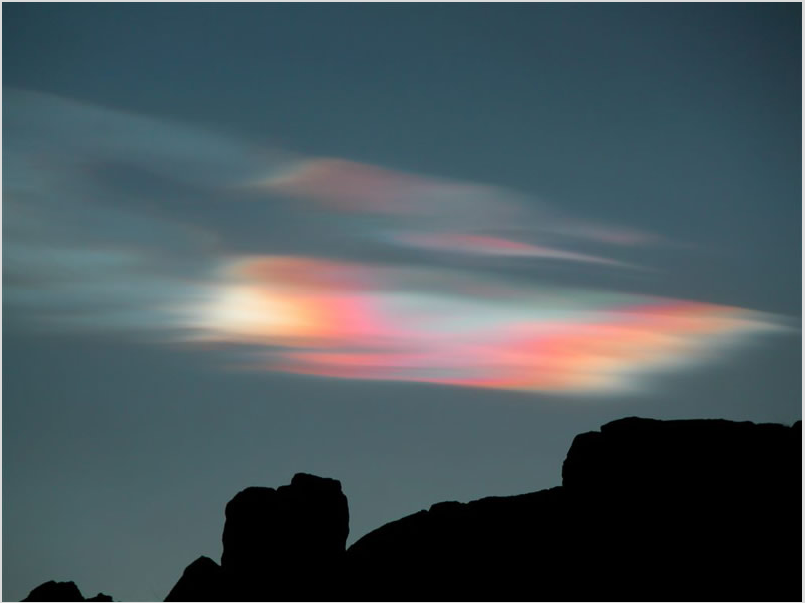Nacreous cloud - Iceland
Nacreous Cloud - Iceland: A Spectacular Atmospheric Phenomenon
Nacreous clouds, also known as mother-of-pearl clouds, are a rare and breathtaking atmospheric phenomenon that occurs in the polar regions. These vibrant, iridescent clouds are a sight to behold, with their shimmering colors and ethereal appearance. While they can occur in various locations around the world, Iceland is particularly known for its spectacular displays of nacreous clouds.
What are Nacreous Clouds?
Nacreous clouds are a type of polar stratospheric cloud that forms at very high altitudes in the Earth's atmosphere, typically between 15 and 25 kilometers above the surface. They are composed of tiny ice crystals that refract sunlight, creating stunning displays of vivid colors. The unique structure and composition of these clouds give them their iridescent appearance, resembling the delicate shimmer of a pearl or mother-of-pearl.
The Optimal Conditions in Iceland
Iceland's geographical location makes it an ideal place for observing nacreous clouds. Situated close to the Arctic Circle, the country experiences long polar nights during the winter months, providing extended periods of darkness. This darkness, combined with the presence of stable atmospheric conditions, creates the perfect environment for the formation of nacreous clouds.
The Science Behind the Colors
The mesmerizing colors displayed by nacreous clouds are a result of a phenomenon called scattering. As sunlight passes through the ice crystals in the cloud, it is scattered in different directions due to the varying sizes and shapes of the crystals. This scattering process separates the sunlight into its constituent colors, similar to how a prism splits light into a rainbow. The result is a breathtaking display of vibrant hues, ranging from pinks and purples to blues and greens.
The Importance of Stratospheric Conditions
Nacreous clouds are primarily formed in the stratosphere, the second layer of the Earth's atmosphere. The unique combination of low temperatures and high moisture content in this region allows for the formation of these delicate ice crystals. Stratospheric conditions, such as the presence of polar vortices and temperature inversions, play a crucial role in creating the stable environment necessary for nacreous cloud formation.
The Role of Volcanic Activity
Iceland's volcanic activity also contributes to the occurrence of nacreous clouds. Volcanic eruptions release large amounts of particles and gases into the atmosphere, which can act as nuclei for ice crystal formation. These volcanic aerosols provide a surface for water vapor to condense upon, enabling the growth of ice crystals and the subsequent formation of nacreous clouds.
The Rarity and Significance
Nacreous clouds are considered rare phenomena due to their specific requirements for formation. They are typically only observed in polar regions during the winter months when the stratosphere is coldest. Their rarity adds to their allure, making them a highly sought-after sight for atmospheric optics enthusiasts and photographers alike.
Observing Nacreous Clouds Safely
While witnessing nacreous clouds can be a truly awe-inspiring experience, it is essential to take precautions when observing them. Directly looking at the sun, which is often low on the horizon during nacreous cloud displays, can be harmful to the eyes. Therefore, it is recommended to use proper eye protection, such as solar filters or eclipse glasses, to safely enjoy these remarkable natural phenomena.
Capturing the Beauty
Photographing nacreous clouds can be a challenging yet rewarding endeavor. To capture their vibrant colors and delicate structure, photographers often use long-exposure techniques and adjust their camera settings accordingly. The unique interplay of light and ice crystals creates a dynamic subject that can result in stunning photographs that showcase the ethereal beauty of nacreous clouds.
A Testament to Nature's Splendor
Nacreous clouds in Iceland are a testament to the extraordinary beauty and complexity of the Earth's atmosphere. Their iridescent colors and otherworldly appearance serve as a reminder of the wonders that can occur in our natural world. Whether witnessed firsthand or admired through photographs, these stunning atmospheric phenomena leave a lasting impression and inspire awe in all who have the privilege of experiencing them.

Nacreous cloud, Iceland
Imaged by Hákon Hansson at Breiðdalsvík on the East Coast of Iceland, 18th February 2005 1800 hrs.
The sun had set 48 minutes previously and was nearly 6° below the horizon.
©Hákon Hansson, shown with permission.
Note: this article has been automatically converted from the old site and may not appear as intended. You can find the original article here.
Reference Atmospheric Optics
If you use any of the definitions, information, or data presented on Atmospheric Optics, please copy the link or reference below to properly credit us as the reference source. Thank you!
-
<a href="https://atoptics.co.uk/blog/nacreous-cloud-iceland/">Nacreous cloud - Iceland</a>
-
"Nacreous cloud - Iceland". Atmospheric Optics. Accessed on April 19, 2024. https://atoptics.co.uk/blog/nacreous-cloud-iceland/.
-
"Nacreous cloud - Iceland". Atmospheric Optics, https://atoptics.co.uk/blog/nacreous-cloud-iceland/. Accessed 19 April, 2024
-
Nacreous cloud - Iceland. Atmospheric Optics. Retrieved from https://atoptics.co.uk/blog/nacreous-cloud-iceland/.